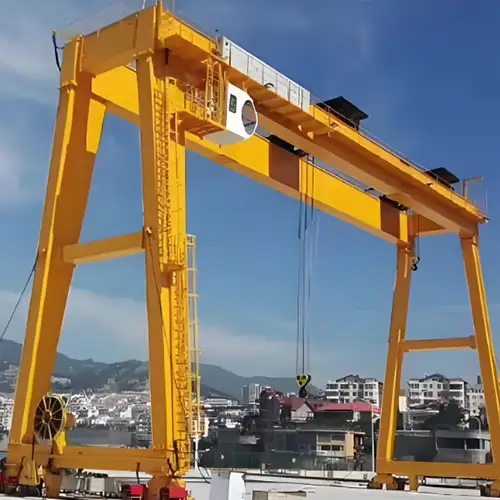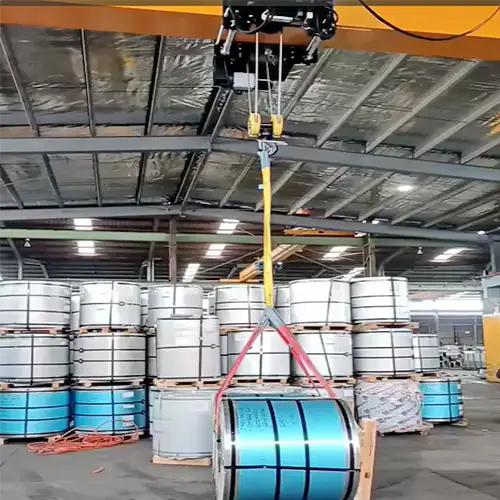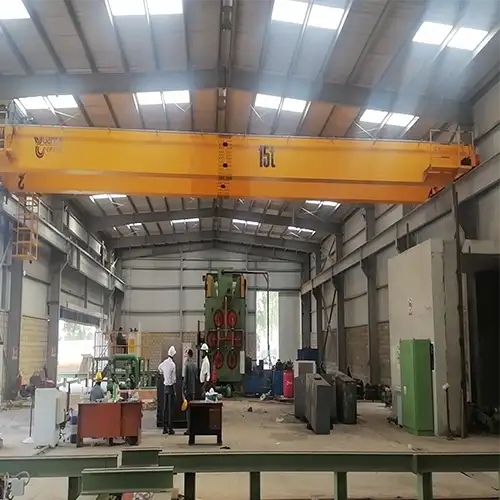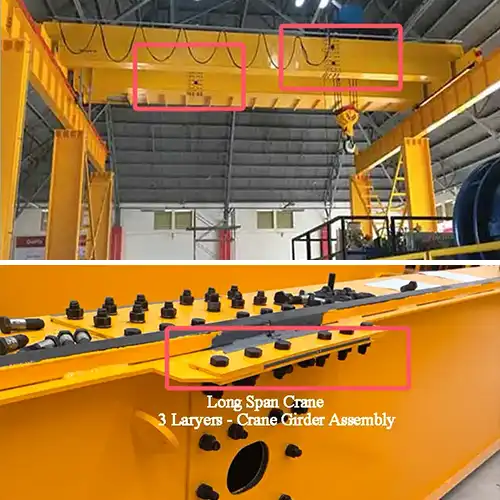Why Gantry Cranes with Two Hooks Improve Productivity
Dual-hook gantry cranes offer balanced lifting, better control, & faster handling of long, heavy loads across various industrial applications. Check now!
Category: Featured
Your Trusted Gantry Crane Manufacturer & Supplier
Double the Hooks, Double the Efficiency: Why Gantry Cranes with Two Hooks Boost Productivity
Advantages of Dual-Hook Cranes in Material Handling
Introduction
In large industrial yards, steel warehouses, and outdoor assembly zones, lifting and moving heavy materials is part of the daily grind. A gantry crane is often the equipment of choice—especially when overhead crane systems aren't feasible or when flexibility of movement is required. But not all gantry cranes are built the same.
When you're dealing with long, uneven, or bulky materials, a gantry crane with two hooks can offer a serious improvement in control and efficiency. Instead of lifting everything from a single point, double hook gantry cranes give operators two lifting points—either on the same trolley or separate ones—that can be adjusted for balance and spacing. That can save time, reduce the chance of accidents, and even cut down on how many workers are needed to guide the load.
Let’s be honest: lifting a 12-meter steel beam or a pipe bundle with just one hook isn’t ideal. It twists, it swings, and often requires extra rigging. That’s where a double hook gantry crane really shines.
Why production teams turn to gantry cranes with two hooks:
- They simplify the lifting of long or asymmetrical loads—less twisting, better balance.
- Workers don’t have to spend as much time adjusting rigging and positioning.
- The load can be lifted and placed with more precision, especially when space is tight.
How it helps boost productivity in material handling:
- Reduces lifting and rigging time by letting both hooks lift together or separately.
- Increases safety by lowering the chance of unstable or tilted loads.
- Cuts back on manual effort needed to control or guide materials during lifts.
If your current setup slows down every time you handle oversized materials, or if workers are spending too much time correcting the load position mid-air, it might be time to consider upgrading to a gantry crane with two hooks. It’s not just a more advanced crane—it’s a more practical one for many real-world jobs
What is a Dual-Hook Gantry Crane?
A gantry crane with two hooks is exactly what it sounds like—a crane system equipped with two lifting hooks instead of the standard one. But the benefits go far beyond just having an extra hook. These cranes are built to handle long, uneven, or heavy loads that are difficult to lift from a single central point.
Whether the two hooks are mounted on a single trolley or two separate ones, double hook gantry cranes offer more flexibility in how a load is rigged and lifted. Operators can adjust the distance between the hooks to suit the shape and length of the item being lifted, which makes a huge difference when handling steel beams, large molds, mechanical assemblies, or bundles of pipes.
Here’s how a gantry crane with two hooks works:
- Each hook operates either independently or in synchronization.
- The crane can lift a load from two points at once, keeping it level and steady.
- The operator controls both hooks from a pendant or cabin, adjusting spacing and height as needed.
Structural options for double hook gantry cranes:
- Single trolley with two hooks: Both hooks move together, ideal for balanced lifting where spacing stays constant.
- Double trolley design: Each hook travels separately, which is better for long or awkward loads that require adjustable spacing during the lift.
Typical tonnages and sizes available:
- Lifting Capacity: Common ranges include 5 tons, 10 tons, 20 tons, and up to 50 tons or more depending on design.
- Span Range: From 10 meters to over 35 meters wide, depending on site layout and load type.
- Lifting Height: Usually customizable from 6 to 18 meters or more, based on material height and handling needs.
These cranes are most commonly used outdoors—like in fabrication yards, steel service centers, and infrastructure projects—but they’re also found in large indoor workshops where floor space is limited and multiple-point lifting is required.
If your operations involve handling long or delicate items that need to stay level, a double hook gantry crane could be the practical solution that reduces risk and improves your overall efficiency.
Types of Gantry Cranes with Two Hooks (Within One Trolley)
When both hooks are mounted on a single trolley, the design becomes compact and ideal for long load handling. Below are the most common configurations, categorized by their hoisting systems.
Gantry Crane with Two-Hook Electric Hoist Trolley
This type uses two standard electric wire rope hoists, mounted side by side on one trolley frame.
- Use Case: Light to medium-duty applications requiring basic dual-point lifting.
- Common Capacity: 5 ton + 5 ton, 10 ton + 10 ton.
Features:
- Affordable and simple in structure.
- Easier to install and maintain.
- May offer limited synchronization between hooks.

Gantry Crane with Two-Hook European-Style Hoist Trolley
Fitted with two compact European-style wire rope hoists on a shared trolley, offering better control and efficiency.
- Use Case: Workshop or yard environments that require compact design and smooth, precise operation.
- Common Capacity: 5 ton to 20 ton per hook.
Features:
- Frequency inverter (VFD) for smoother hoisting and traveling.
- Lower wheel load and modular design.
- Better synchronization and energy savings.
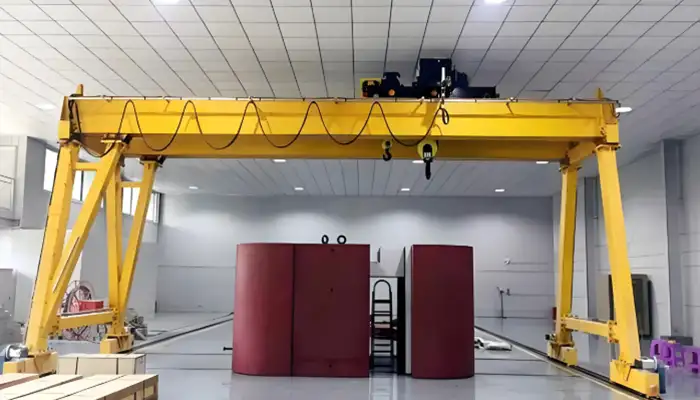
Gantry Crane with Two-Hook Open Winch Trolley
Two heavy-duty open winches are integrated into a single trolley frame for handling large and heavy loads.
- Use Case: Suitable for shipyards, steel plants, and other heavy industries.
- Common Capacity: 30 ton + 30 ton, 50 ton + 50 ton and higher.
Features:
- Robust structure for tough working environments.
- Powerful winch motors and large drums for long lifting height.
- Built for frequent, heavy-duty operations.

Gantry Crane with Two-Hook European-Style Open Winch Trolley
A high-end configuration combining open winch performance with European precision and efficiency.
- Use Case: Demanding projects such as energy, aerospace, or marine component handling.
- Common Capacity: 20 ton + 20 ton to over 100 ton.
Features:
- High-precision VFD-controlled winches with encoder feedback.
- Compact and efficient structure.
- Excellent for delicate, high-precision, and high-load applications.

Gantry Cranes with Two Hooks and Two Trolleys

Single Girder Gantry Crane with Two Trolleys and Two Hooks
Economical Type:: Two independent hoists on separate trolleys run along a single box girder. Suitable for outdoor or semi-outdoor use in yards handling light steel structures, pipes, or small containers.
- Freestanding or rail-mounted designs
- Weatherproof hoists available
- Typically used in medium-size fabrication or storage yards

European Crane Design:: Compact European hoists on modular gantry frames allow better hook approach and more reliable travel, especially for sites with limited space.
- Lower noise and higher lifting precision
- Available with VFD for soft start/stop motion
- Ideal for modern construction material handling
Double Girder Gantry Crane with Two Trolleys and Two Hooks
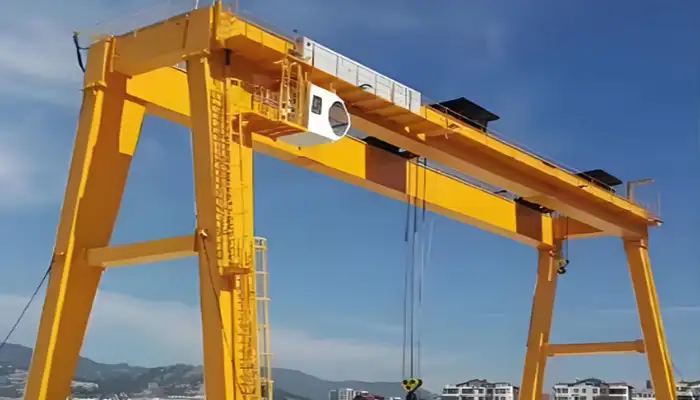
Economical Type: This version uses standard trolleys (open winch or hoist type) on a strong twin-beam gantry frame. It's popular in large yards, shipyards, and steel storage facilities.
- Common capacity ranges: 10 + 10 tons, 20 + 10 tons
- Rail or track-mounted with basic weather protection
- Separate operation of each trolley, or optional master control panel
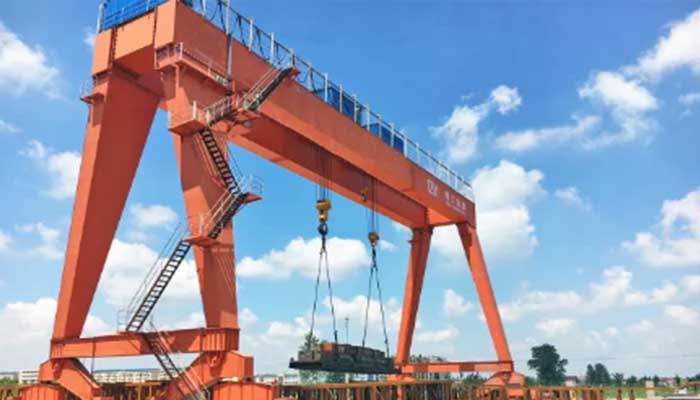
European Crane Design: For buyers needing high performance and precise synchronization, the European type provides advanced features.
- Modular open winch trolleys with programmable logic
- High anti-sway performance, even under strong winds
- Designed for 24/7 operations in heavy-duty environments
Two-hook, two-trolley cranes give buyers more control and lifting flexibility — ideal for long, awkward, or multi-point loads. Choosing between economical vs. European-style designs depends on your lifting frequency, precision needs, and budget. Contact us to get the cost-effective solution for your needs.
Key Advantages of Dual-Hook Gantry Cranes
Choosing a gantry crane with two hooks isn’t just about having an extra lifting point. It’s about working smarter when the job involves long, heavy, or oddly shaped materials. Whether you're moving steel beams or positioning machinery frames, double hook gantry cranes give you control that a single-hook system simply can’t match.
Let’s look at why more operations are turning to these cranes—and how they actually help in day-to-day work.
Enhanced Load Stability
When you're lifting long items—like steel pipes, structural beams, or mechanical shafts—balance is everything. A load that tilts or swings is not only harder to handle but also more dangerous.
- A gantry crane with two hooks lifts from two points, which keeps the load level and minimizes swinging.
- It helps reduce stress on the load itself, especially important when lifting delicate or hollow sections.
- There's less need for on-the-spot rigging adjustments, so the lift is cleaner and safer.
Increased Lifting Flexibility
One of the biggest benefits of double hook gantry cranes is flexibility—something you’ll appreciate the moment you lift two items or need to shift a long beam sideways into position.
- The hooks can either move together or be operated independently, depending on the crane design.
- You can handle asymmetrical loads or adjust hook spacing to match the lifting points on the load.
- In projects where space is limited or precision is required, having that second hook makes all the difference.
Time-Saving in Complex Lifts
Time adds up fast on any job site. The more time you spend setting up slings, readjusting hooks, or guiding the load by hand, the slower your progress—and the higher your labor costs.
- A gantry crane with two hooks often eliminates the need for complicated sling setups or spreader bars.
- You can pick up and move multi-point loads much faster, with less fuss and fewer people involved.
- It's a practical way to shave minutes off every lift, which adds up over the course of a day.
Improved Worker Safety
When operators have better control of the load, everyone around the crane stays safer. This isn’t just a bonus—it’s essential in busy work environments like shipyards or steel plants.
- Less manual involvement means fewer chances for pinched fingers, pulled muscles, or worse.
- A stable, well-balanced lift is easier to control, especially in windy conditions or when visibility is limited.
- In high-traffic or hazardous zones, the smooth operation of double hook gantry cranes helps avoid accidents before they happen.
Versatility Across Industries
These cranes aren’t limited to one niche. Their value shows up in a wide range of settings—indoors and out.
- Widely used in shipbuilding, where long structural pieces need precise lifting and placement.
- Common in steel fabrication, machinery assembly, power equipment yards, and even precast concrete plants.
- Suitable for outdoor gantry setups in storage yards or indoor bays where two-point lifting improves layout efficiency.
Design Options and Considerations
Choosing the right gantry crane with two hooks isn’t just about capacity—how the crane is put together matters just as much. Below are the main design decisions to weigh before you sign off on the drawings.
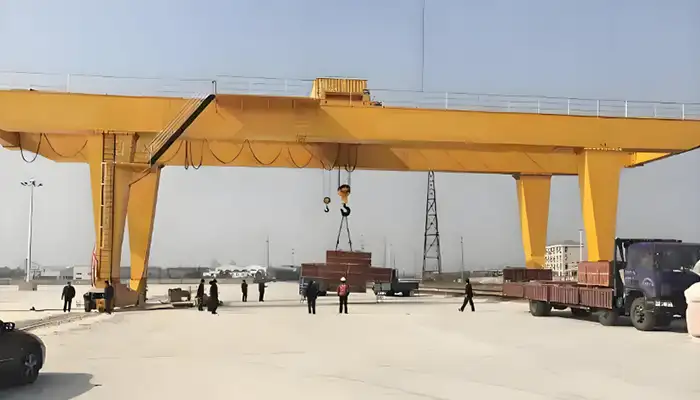
gantry crane with main hook and axuliary hook trolley

gantry crane with two trolleys
Single-Trolley vs. Dual-Trolley Systems
A quick way to picture the difference: one trolley means both hooks ride the same carriage; two trolleys means each hook has its own ride.
Single trolley with two hooks
- Hooks keep a fixed distance—great when you always lift the same style of load (think straight steel beams).
- Fewer motors and drives to maintain, so the maintenance schedule is lighter.
- Lower upfront cost and simpler electrical wiring.
Dual-trolley (independent) design
- Each hook travels on its own trolley, letting you open or close the spacing to match awkward or varying loads.
- Perfect for modules with off-center weight or frames that need a slight tilt during set-down.
- Slightly higher cost and more moving parts, but the flexibility pays off in reduced rigging time.
Synchronous Hook Control Systems
Keeping the two hooks in step is what makes double hook gantry cranes feel smooth instead of jittery. Modern control tech does the heavy lifting.
- Basic electrical interlock—both hoists wired to run together; economical and works well when load balance rarely changes.
- Variable-frequency drives (VFDs)—each motor speeds up or slows down in real time, trimming sway and matching hook height within millimeters.
- PLC-based synchronization—a small controller watches encoders on both hoists and adjusts automatically; ideal for critical lifts where tolerance is tight.
Load Capacity and Span Configurations
Not every yard needs a 50-ton monster; pick what covers today’s needs without boxing in tomorrow’s growth.
- Typical working range: 5 t, 10 t, 20 t, up to 50 t per hook, with custom builds beyond that.
- Span options: standard 10 m–35 m; wider is possible, but check rail alignment and wheel loads.
- Future upgrades: design the runway for a heavier crane now, then drop in beefier hoists later—cheaper than rebuilding the whole track.
Power Supply and Installation Conditions
Even the best crane won’t help if the site can’t feed it juice or fit it in the footprint.
Power feed choices:
- C-track festoon—good for medium spans; easy to inspect.
- Conductor bars—clean, low-drag option for long travels and high duty cycles.
- Cable reel—handy when the crane moves beyond a fixed runway, such as a yard on rails.
Site prep:
- Check concrete strength under the wheel paths—double hooks mean higher point loads.
- Verify clearance for hook travel at both ends of the span; a snagged load stops the whole line.
- For outdoor cranes, add a storm-lock or rail clamp so wind doesn’t roll the crane when idle.
Taking time to match these design details to your workflow ensures the gantry crane with two hooks earns its keep from day one—no surprises, no retrofits, just smooth lifts.
Cost vs. Value Analysis
Investing in a gantry crane with two hooks may look like a higher upfront expense compared to a single-hook model—but the true value shows up over time. In industrial operations where every hour counts, it’s not just about what you spend at the beginning—it’s about what you save and gain throughout the crane’s working life.
Initial Investment vs. Long-Term Productivity Gain
Yes, double hook gantry cranes cost more to purchase and install. You’re paying for additional hoisting mechanisms, more complex control systems, and sometimes dual trolleys. However, that investment quickly turns into value when you measure how much more efficiently the crane handles challenging loads.
- You save time on every lift by avoiding extra rigging, re-lifting, or repositioning.
- When operators spend less time preparing for each hoist, more jobs get done in the same shift.
- Over time, the increased load-handling speed and control directly contribute to higher output, especially in fabrication and assembly environments.
If you're working with long steel beams, precast components, or machinery frames on a daily basis, the added investment typically pays for itself within the first 1–2 years of active use.
Reduced Downtime and Improved Throughput
Downtime is expensive—not just in repairs, but in lost momentum. With a gantry crane with two hooks, you minimize the kind of issues that often slow down a worksite.
- Fewer delays due to improper rigging or unstable loads.
- Lower risk of damaging expensive materials during lifting, thanks to better balance and smoother hook control.
- Less need to bring in auxiliary lifting equipment (like forklifts or spreader beams), streamlining operations.
The smoother the lift, the faster you can move materials, align them, and move on to the next task. Over a full production schedule, those minutes saved per load become hours—and then days—of regained productivity.
Lower Labor Costs for Load Handling
Manpower is one of the biggest variable costs in material handling. A double hook gantry crane helps reduce the number of workers needed per lift and lessens the physical involvement required from ground staff.
- Fewer riggers are needed when the hooks do the balancing.
- Operators can perform complex lifts solo or with minimal assistance.
- Ground staff don’t have to manually guide or correct swaying loads, reducing risk of injury and fatigue.
When you reduce reliance on manual labor for load alignment and handling, you're not just saving on wages—you’re also lowering safety risks, reducing training time, and making your operation less vulnerable to staffing shortages.
While the upfront price tag of a gantry crane with two hooks may be 15–30% higher than a single-hook model, the value in daily operations, time savings, labor reduction, and throughput improvement is much higher. If your workflow involves frequent long or multi-point lifts, the return on investment isn’t just theoretical—it’s visible in your output, payroll, and job-site safety.
Buyer Checklist for Choosing a Dual-Hook Gantry Crane
Purchasing a gantry crane with two hooks is not a one-size-fits-all decision. The crane must be selected to match your materials, lifting conditions, and operating environment. The checklist below will guide buyers—especially those in steel yards, fabrication shops, and heavy assembly plants—toward a practical and well-suited choice when considering a double hook gantry crane.
Type and Size of Materials Handled
Start with the load characteristics, as they determine most of your crane’s structure and function.
- Are the materials long, uneven, or bulky (for example, steel pipes, machinery housings, or pre-fabricated frames)?
- What is the average weight of the loads, and what is the maximum you’ll need to lift?
- Will the items need to stay level during lifting, or can they be slightly offset?
- Do your lifting jobs involve mostly uniform products, or are they varied and changing?
If your loads vary in size or weight distribution, a dual-trolley configuration with independent hook spacing is often the better choice.
Desired Level of Automation or Synchronization
Control style and hook movement coordination can affect both efficiency and safety.
- Do you require both hooks to lift simultaneously at a fixed distance, or independently?
- Would simple electrical interlocking be sufficient, or is precise hook leveling important for your workflow?
- Do you need remote control, pendant operation, or an operator cabin for better visibility?
For applications that demand precise positioning, such as placing large mechanical components or modules, it’s recommended to use synchronization systems with encoder feedback or programmable logic controls.
Installation Environment and Mobility Needs
Your physical site conditions will influence the crane’s layout, mobility, and required protective features.
- Is the crane going to be installed indoors or outdoors?
- How long is the runway or travel length?
- Does the ground structure support wheel loads, or will reinforced rail foundations be needed?
- Is this a stationary crane system, or will it need to move across multiple bays or sections of the yard?
For outdoor or mobile use, consider structural protection against wind, moisture, and temperature variations, and choose appropriate travel gear or weather-resistant controls.
Budget and Lifecycle Expectations
A cost-effective solution balances your short-term spending with long-term usability and reliability.
- What is your available budget for this crane project?
- Will the crane operate daily in a high-throughput production line or serve in occasional use?
- Do you have trained maintenance staff, or will ongoing support be outsourced?
- Are you looking for a crane that meets today’s needs or one that can be scaled up for heavier or more frequent loads in the future?
Higher initial investment in durable components and flexible design often reduces total cost of ownership by minimizing downtime and maintenance over the crane’s lifespan.
Every double hook gantry crane project should start with a clear understanding of your lifting needs, materials, and working conditions. A well-matched system will perform reliably, reduce unnecessary handling steps, and improve safety on-site. Be sure to communicate detailed requirements to your crane manufacturer—including load data, workspace constraints, and workflow needs—to ensure the crane is designed for real-life operation, not just a general-purpose application.
Conclusion
Boosted Productivity and Safety: Dual-hook gantry cranes streamline your lifting processes by handling longer and heavier loads with greater stability. This reduces rigging time and load adjustments, speeding up operations and increasing daily output. At the same time, better load balance means fewer accidents, less load sway, and a safer environment for operators and ground personnel.
A Strategic Investment for Material Handling: Upgrading to a gantry crane with two hooks isn’t just about having more lifting power—it’s about enhancing flexibility and control. Whether you’re moving steel beams, large assemblies, or other bulky materials, this crane type handles complex lifts with ease. The result is smoother workflows, less downtime, and adaptability for changing load requirements.
Partnering for the Best Solution: No two lifting scenarios are exactly alike. To maximize the benefits of a double hook gantry crane, work closely with a crane manufacturer who listens to your specific needs. Customized designs, expert installation, and reliable after-sales service ensure the crane fits your operation perfectly and performs safely and efficiently over the long term.
Related Products
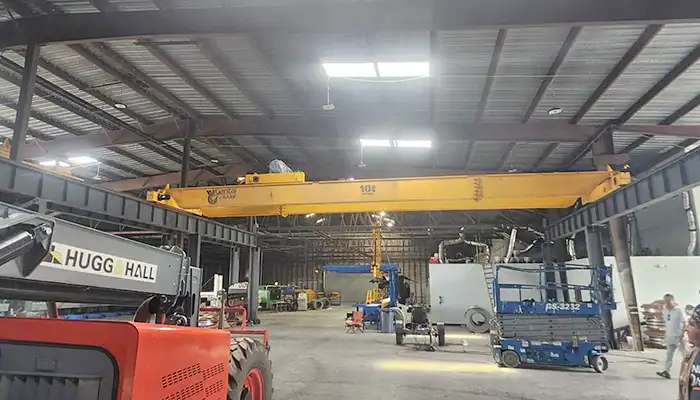
Affordable 10 ton double girder overhead crane with CD/MD hoist trolley, built for U.S. standards, ideal for construction and industrial lifting
Free consultation to Confirm Parameters & Specifications and Get
Latest Crane Price & Crane Rate.
- Types of overhead cranes : _______?
- Optional: Overhead travelling crane, goliath gantry crane,Slewing jib crane, Single girder or double girder crane,small portable crane or kbk crane, etc.
- Capacity of overhead crane: _______?
- Optional: 0.25ton, 0.5 ton, 1 ton, 2 ton, 3ton, 5 ton, 10 ton,15ton, 20ton, 25 ton, 30ton,35ton, up to 550ton, etc.
- Crane span & lifting height : _______?
- Crane travelling length : _____?
- Control of overhead crane:_______?
- Optional: pendant/ remote/cabin control
- Voltage supply of overhead crane:_____?
- Eg,: 380V50/60HZ,3Phase or others,etc.
- Application/usage of crane:_______?
- Eg,: Steel mill, ,injection mold, cement,stone, concrete,granite, general manufacturing, etc.
Just leave a message via the contact form and our hoist and crane engineer will contact you with in 24working hours.
Get In Touch
